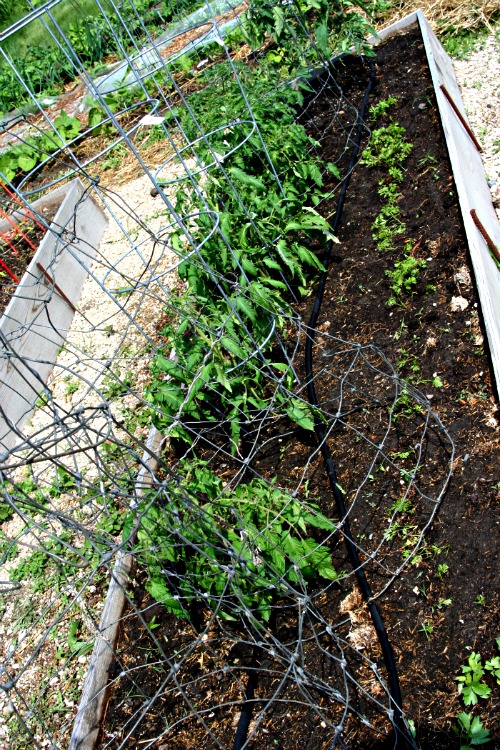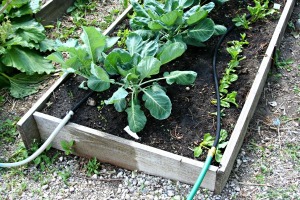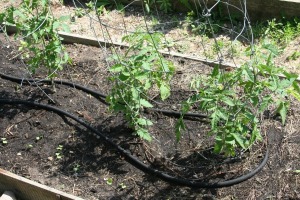 Last night we had our first real “extreme weather” of the season. No tornado, but winds up to 70 mph, and 3-5 inches of rain in the space of a few hours.
Last night we had our first real “extreme weather” of the season. No tornado, but winds up to 70 mph, and 3-5 inches of rain in the space of a few hours.
This morning, it was easy to see which direction the wind had been blowing– every plant was pointing, or flattened, south. We lost a gorgeous white pine that tipped over into the pond, and a giant maple was pulled up by the roots a few blocks away. Yet, oddly, the lawn furniture didn’t blow off the dock into the pond!
Still, the farmers are relatively lucky because planting was late this year. The corn is not close to being knee high (two weeks from the Fourth of July), and the little plants will probably have no trouble popping back up again.
This week I started a water-related project in the garden. Last year I realized the garden had gotten a little too big for me to water by hand, and I think my low yields had a lot to do with the drought and my impatience standing with a hose. Also, I know it’s better for tomatoes to water from below, not splashing dirt up on the leaves, which causes blight. Knowing we’ll be gone for a week in July, I also wanted a system in place that will make it easier for my sister-in-law to water for me.
 Last weekend, on the way to the cabin and back, I mostly thought about what it would take to make a drip irrigation system. I have no experience with this, but saw a system on an expensive gardening supply website, and it seemed doable with regular hose and soaker hoses. I’m still intimidated by the hardware store, but I worked myself up enough to try it.
Last weekend, on the way to the cabin and back, I mostly thought about what it would take to make a drip irrigation system. I have no experience with this, but saw a system on an expensive gardening supply website, and it seemed doable with regular hose and soaker hoses. I’m still intimidated by the hardware store, but I worked myself up enough to try it.
In fact, it was really easy. Hoses are easy to cut, and a soaker hose fits neatly inside a regular hose for splicing. Originally I tried putting male/female ends on the cut hoses, but the soakers are just a little too narrow and rip as I push the piece into place. This way is easier, and the clamps for attaching the hoses are cheap!
 I bought two 50-foot soaker hoses and cut those in half, making enough for two rows in each 12-ft bed. I also bought two 15-foot regular hoses and cut one in half, attaching the three pieces to the soaker hoses. This means I can run a single hose between four beds without also watering the ground in between them.
I bought two 50-foot soaker hoses and cut those in half, making enough for two rows in each 12-ft bed. I also bought two 15-foot regular hoses and cut one in half, attaching the three pieces to the soaker hoses. This means I can run a single hose between four beds without also watering the ground in between them.
 Four hoses is about all I’d want to do, as the water pressure goes down the farther you are from the source, and the last bed doesn’t get as much water as the first. However, I’ve built another system to cover four beds on the east side of the garden. I’ll give the heaviest water to the tomatoes, cucumbers and squash, and less to beets, beans, peppers and broccoli. I’m also going to run a single 50-ft soaker along the potato/onion bed.
Four hoses is about all I’d want to do, as the water pressure goes down the farther you are from the source, and the last bed doesn’t get as much water as the first. However, I’ve built another system to cover four beds on the east side of the garden. I’ll give the heaviest water to the tomatoes, cucumbers and squash, and less to beets, beans, peppers and broccoli. I’m also going to run a single 50-ft soaker along the potato/onion bed.
Now I can go out and hook up the hose to one system, leave it for a half hour, move it to the other side, and then move it to the potatoes. There are four more beds that I will still water by hand, but maybe eventually I’ll assemble yet another system like this.
However, it’s not necessary now, as more rains are predicted for tonight. But when it gets hot and dry, it gets really hot and dry, and now I’m ready!



Something very symbolic of preparing for drought in the midst of a rainy spell! Your gardens look so good.
Sounds like a plan! I’m eager to hear how this works.
It’s starting to get a little dry here so I’ve been watering this week.
However, it’s thundering as I’m writing this. I hope we get a nice soaking rain:)
Mom